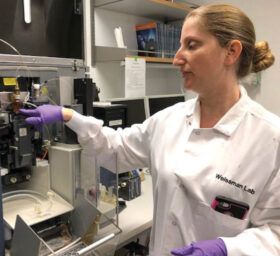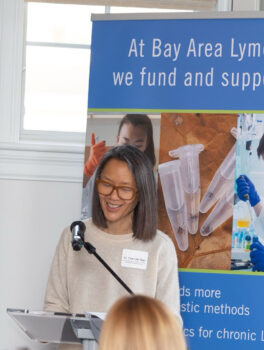Distinguished Speaker Series Transcript
 “I want to leave you with hope. I think we’re going to be unstoppable because I think that these are solvable problems. These are answerable questions. I think that there are already a lot of existing tools in immunology that just need to be brought into the fight, and we can change this.”
“I want to leave you with hope. I think we’re going to be unstoppable because I think that these are solvable problems. These are answerable questions. I think that there are already a lot of existing tools in immunology that just need to be brought into the fight, and we can change this.”
– Michal Caspi Tal, PhD
Michal Caspi Tal: In the chronic illness world, I think that there is something about hope with a capital ‘H’ that is precious. I think it always has to be. I want to talk a little bit about what my lab is doing, where I think we could go in the future and the hope that I have for how we move forward, how we solve this, and how we change this for those who come after us. So, I’ll tell you a little bit about some of the recent things that have come out of the lab, what the lab is working on now, and where we want to go.
New Study Shows How Borrelia burgdorferi Evades the Immune System
Recently, we published a study in collaboration with Hanna Ollila’s lab where we compared people who’ve had Lyme and have had a diagnosis of Lyme versus people who’ve never had a diagnosis of Lyme. We found a genetic difference in a sweat protein that nobody—including me—had ever thought about before. We tested it against the bacteria in our lab, and we saw that it had a huge effect; we tested it in mice, and it had a huge effect. So that’s really exciting. We had another paper that came online yesterday that is one of these last papers from my postdoctoral work over at Stanford, where we actually managed to figure out some of how Borrelia burgdorferi, the bacteria that causes Lyme, manages to evade immune clearance.
 Any respectable pathogen that can establish a persistent infection needs to figure out your immune system to the point that it can evade it. The fact that it has persisted means that it was able to evade your immune clearance. And so, I got to that from a very interesting direction working on immune regulation, trying to understand these brakes on the immune response and how they impact the response to infection. The immune system has the power to kill you and obviously, nobody has any incentive for that to happen. So, there are a lot of mechanisms in place to put brakes on the immune system and reign it in. One of the huge developments in cancer over the last two decades has been reevaluating the question: can we take those brakes off? So in my postdoc, I was studying a particular checkpoint where this was turning into an exciting immuno-oncology target, and I said, ‘I want to look at how this checkpoint is used in infection.’ I realized that this checkpoint was being used to help you survive an acute infection, but created a vulnerability for pathogens to evade immune clearance and establish chronic infection much like it allows cancer cells to evade immune clearance. In an amazing collaboration with Irv Weissman, Balyn Zaro, and Jenifer Coburn we realized that the bacteria that cause Lyme disease manipulate this brake and that’s how I became fascinated with Lyme. But I also became concerned about turning off this brake in cancer patients because I was concerned about what would happen if you used this on cancer patients during an active infection. Indeed, the clinical trials on this drug were ended due to increased death from infection, and I wish it hadn’t been tested during a worldwide pandemic.
Any respectable pathogen that can establish a persistent infection needs to figure out your immune system to the point that it can evade it. The fact that it has persisted means that it was able to evade your immune clearance. And so, I got to that from a very interesting direction working on immune regulation, trying to understand these brakes on the immune response and how they impact the response to infection. The immune system has the power to kill you and obviously, nobody has any incentive for that to happen. So, there are a lot of mechanisms in place to put brakes on the immune system and reign it in. One of the huge developments in cancer over the last two decades has been reevaluating the question: can we take those brakes off? So in my postdoc, I was studying a particular checkpoint where this was turning into an exciting immuno-oncology target, and I said, ‘I want to look at how this checkpoint is used in infection.’ I realized that this checkpoint was being used to help you survive an acute infection, but created a vulnerability for pathogens to evade immune clearance and establish chronic infection much like it allows cancer cells to evade immune clearance. In an amazing collaboration with Irv Weissman, Balyn Zaro, and Jenifer Coburn we realized that the bacteria that cause Lyme disease manipulate this brake and that’s how I became fascinated with Lyme. But I also became concerned about turning off this brake in cancer patients because I was concerned about what would happen if you used this on cancer patients during an active infection. Indeed, the clinical trials on this drug were ended due to increased death from infection, and I wish it hadn’t been tested during a worldwide pandemic.
Infection-associated Chronic Illnesses Are Extremely Complex

I think that what’s going on with these infection-associated chronic illnesses is that we’re looking at extremely complex heterogeneous groups of people, some of whom are struggling with persistent infection, some of whom have now had these ‘multiple hits’ that Dr. Charlotte Mao was talking about this evening. Maybe you had other infections that you kept under control, but now you’ve introduced this new infection that’s redirecting your immune resources and now this other thing isn’t under control. Or these two things don’t ‘play nicely’ or they bring out the worst in each other. There’s a lot of different impacts there. And then there’s also how your immune system and your immune response could be changing as a result of having had this infection that is now making you extremely vulnerable to other exposures. So I want to give you guys a few examples and some of the things that we’re thinking about in this space and how I think we could change how we look at all of this.
“I think that what’s going on with these infection-associated chronic illnesses is that we’re looking at extremely complex heterogeneous groups of people, some of whom are struggling with persistent infection, some of whom have now had these ‘multiple hits.’ And your immune response could be changing as a result of having had this infection that is now making you extremely vulnerable to other exposures.”
– Michal Caspi Tal, PhD
From the moment I got to MIT, I worked with my team and rallied the incredible people who created the Center for Gynepathology Research and the Center for Clinical and Translational Research at MIT to try to create the largest clinical study that has ever been at MIT. And it is a study of humility where we are admitting to everybody that we have no idea, we have no understanding of why so many things are going catastrophically wrong across infection-associated chronic illnesses. This is a compare and contrast study where we are trying to profile everything that we can think of. This is a ‘leave no stone unturned’ study. This study will make me broke, and it constantly does because feeding this thing is a monster, but we’re already learning so much. We’re asking: were you hypermobile before the infection? Are you hypermobile now? Did you have dysautonomia before the infection? Do you have dysautonomia now? Do you have neurocognitive impacts? We’re doing a whole slew of neurocognitive assessments from eye-tracking, to electricity that’s coming out of your brain, to how you play a video game. We’re looking at all of it in comparison to some of these more classical neurology studies. We’re doing very deep pathogen profiling, immune profiling, and genetic features. Everything that we can think of that we’ve heard about, we’re looking for it.
How Philanthropy Has Enabled the MAESTRO Study

I want to acknowledge the fact that Bay Lyme Foundation gave me a grant and an Emerging Leader Award around this work that we had started back in 2016 on how Borrelia burgdorferi is evading immune clearance. And at that gala where I received that award, I met an incredible philanthropist, Emily Fairbairn. She has been such a mentor to me, and I tremendously respect her whole approach in this because her mantra is to turn pain into purpose, her own pain that she experienced, and that of her family. She is trying to change things for others. She has motivated a lot of what we’ve done with the MAESTRO Study and enabled launching it. I can’t tell you how many papers I think are going to come out of this study. I mean, I think this is going to be amazing.
Now I want to tell you a little bit about what my lab is focused on doing. I think that earlier in this research with more limited tools, we’d been asking the wrong questions. I think that we needed to ask a much more open-ended question of the immune system of how it’s responding. What my lab is trying to do is something that I’m calling ‘mapping illness trajectories’ or ‘developing predictive diagnostics.’ And the point of this is to ask the immune system: these pathogens that you have encountered or different bacteria that you have encountered, how did you respond to them?
“We’d been asking the wrong questions. I think that we needed to ask a much more open-ended question of the immune system of how it’s responding.”
– Michal Caspi Tal, PhD

Inflammation and Antibody Responses Can Be Extremely Nuanced
The way we do clinical serology right now is that when you get tested for Lyme is through an indirect antibody test asking: do you have a certain type of antibodies to Lyme? And these tests were developed at a time when you had to pick one thing to look for. So this thing, the most obvious thing to pick would be this type of antibody called IgG.
Let me explain the problem with this amount of information. I hate the terms inflammatory and anti-inflammatory because your immune system is so much more nuanced and complex than that. There are flavors of inflammation, and these flavors really matter. And if we look and we say there was food that gives you a certain amount of information, but for somebody who has celiac or for somebody who’s vegan, ‘there was food’ is not the necessary amount of information, they need to know if that food contains gluten or if that food contains animal products. They need more details, more nuanced information than ‘there was food.’ And so, as an immunologist who works on infectious diseases, I need more details than there was IgG.
So what kind of details do I need? I need to know about all the different types of antibodies, as this will give me much more nuanced information about flavors of inflammation. And today I don’t need to choose a single type of antibody to look at as was the case with ELISA tests or Western Blot tests. You can take any immunologist off the street—I kid you not—and ask them to run you a 10-color panel on flow. And they could do that. This is not hard today. If any of you want to do some time in my lab, I can train you how to do that. I just got a 25-color flow cytometer courtesy of Massachusetts Life Sciences (MLSC). So there’s no need to pick and choose. So thank you MLSC, that was a real gift. But we look at all of the information we can, and that’s what I want to do so that we can get a better understanding of what type of immune response is underway.
Understanding Who Will Recover From a Lyme Infection, and Who Won’t—and Why
I think that from very, very early in the infection, we can tell apart who is mounting a protective response. They have Lyme, they get over Lyme, and they’re never going to think about it again and this was nothing—versus the people who are not mounting a protective response, and possibly mounting a catastrophic response that is going to bring the house down. Antibodies are these really important proteins in your immune response. They aren’t just biomarkers, they are effector proteins that can turn on different immune features and functions and recruit different types of immune cells. Taking a high-resolution look at the antibodies of different subsets of people who are not mounting a protective response gives you critical information for therapeutic approaches
“I think that from very, very early in the infection, we can tell apart who is mounting a protective response. They have Lyme, get over Lyme, and they’re never going to think about it again and this was nothing. Versus the people who are not mounting a protective response, and possibly mounting a catastrophic response that is going to bring the house down.”
– Michal Caspi Tal, PhD

Is the Future “Personalized” Medicine?
So we’re asking much more nuanced and detailed questions with this approach to really try to understand. Is this the future of personalized medicine? I don’t know. But I do think this is where we have to go. We have to go there for you. How are you responding to the microbes that live in you? How are you responding to pathogens that you’ve been exposed to and what is that going to mean? And I could talk forever about where I want my lab to go with this and the kinds of tests that I envision we could develop. At the moment with MAESTRO, we’re testing what we developed for Lyme called the B-FLIP because it’s flipping how we think about antibodies. (It’s also Flow-Based Immune Profiling and it fits the acronym.) But I think that we are going to be able to tell apart pretty early in the infection who is going on to recover and who’s not, as well as other flavors of that that we’re trying to capture in MAESTRO.
The other thing I want to tell you is that in MAESTRO, we’re asking all these kinds of crazy questions that we’ve heard about from patients. And I had this kind of epiphany moment during my postdoc where I used to tell people that I had the most incredible job in the world because even though I was getting paid peanuts—and I was—it is funny because they say if you love your job, you’ll never work a day in your life and you’ll work every day in your life. And it’s so true. But I used to tell people that the reason I have the best job is that I could wake up in the morning and say, ‘The most important question to ask is X.’ And as I started to learn about chronic Lyme, as I started to understand the incredible magnitude of the situation, how little has been done, how much stigma there is, I did not feel like it was my right to make these decisions on my own. I felt like I had to interact with patients and get advice from patients about what are the most important unanswered questions that people need answered. And to then come at it as an immunologist rethinking how we’re thinking about this. But I needed to know what the important questions were, and I didn’t feel like it was my place to decide that. And I have engaged with patients tremendously and have expert patients as part of my team and as mentors. And that has helped inform MAESTRO and the things that we’re asking in our clinical study. And it has also informed a lot of our animal research.
“As I started to learn about chronic Lyme, as I started to understand the incredible magnitude of the situation, how little has been done, how much stigma there is, I did not feel like it was my right to make these decisions on my own. I felt like I had to interact with patients and get advice from patients about what are the most important unanswered questions that people need answered.”
– Michal Caspi Tal, PhD
Listening to Patients is Key to Research Direction
Some of the things that patients were complaining about were EDS (Ehlers-Danlos syndrome), dysautonomia, and hypermobility, these things are happening that weren’t there before the infection. And I just want to tell you that I have been able to establish different mouse models of chronic Lyme where they acquire some of these same disease features that patients are reporting. So, when you start to have this dialogue between patients and researchers and use the tools that are available to us today in a new way to try, we can start to answer these important questions.
I want to leave you with this hope that I think we’re going to be unstoppable because I think that these are solvable problems. These are answerable questions. This isn’t actually rocket science. And I think that there are already a lot of existing tools in immunology that haven’t been brought into the fight that just need to be brought into the fight and we can change this. So I want to leave you with that hope.
Note: Dr. Tal’s lab is actively recruiting people with acute Lyme disease for the MAESTRO study. The goal of the study is to capture a snapshot of what is happening at this early stage of a Lyme disease infection. In addition, the information gathered will be key for testing and further developing an understanding of the different immune features of chronic Lyme. To learn more about the study and check eligibility for participation, visit Dr. Tal’s MAESTRO website here.
Michal Caspi Tal, PhD, is Principal Scientist, at the MIT Department of Biological Engineering & Associate Scientific Director, at the MIT Center for Gynepathology Research. Dr. Tal leads the Tal Research Group within the Department of Biological Engineering and also serves as the associate scientific director of the Center for Gynepathology Research. Michal is working to identify the connections between infections and chronic diseases. Her research is focused on creating predictive diagnostics and generating actionable information providers can use to connect with and care for patients to improve diagnosis and treatments for invisible chronic diseases. From tick-borne disease to COVID, there are many similarities across chronic inflammatory diseases and important sex differences in these responses, which are the focus of the Tal group. Michal received her PhD at Yale University in Immunobiology under the mentorship of Dr. Akiko Iwasaki researching how immune responses to viruses are impacted by processes such as aging. Dr. Tal then did her postdoctoral training in the laboratory of Irving Weissman at Stanford where she later became an instructor at the Institute for Stem Cell Biology and Regenerative Medicine at Stanford University leading the infectious disease team and studying immunomodulatory mechanisms that impact immune clearance of infectious disease, with a focus on Lyme disease. Michal has been awarded NIH NIAID F31 and F32 pre and postdoctoral fellowships, as well as the Emerging Leader Award from Bay Area Lyme Foundation.
This blog is part of our BAL Leading the Way series. If you require a copy of this article in a bigger typeface and/or double-spaced layout, contact us here. Bay Area Lyme Foundation provides reliable, fact-based information about Lyme and tick-borne diseases so that prevention and the importance of early treatment are common knowledge. For more information about Bay Area Lyme, including our research and prevention programs, go to www.bayarealyme.org.
